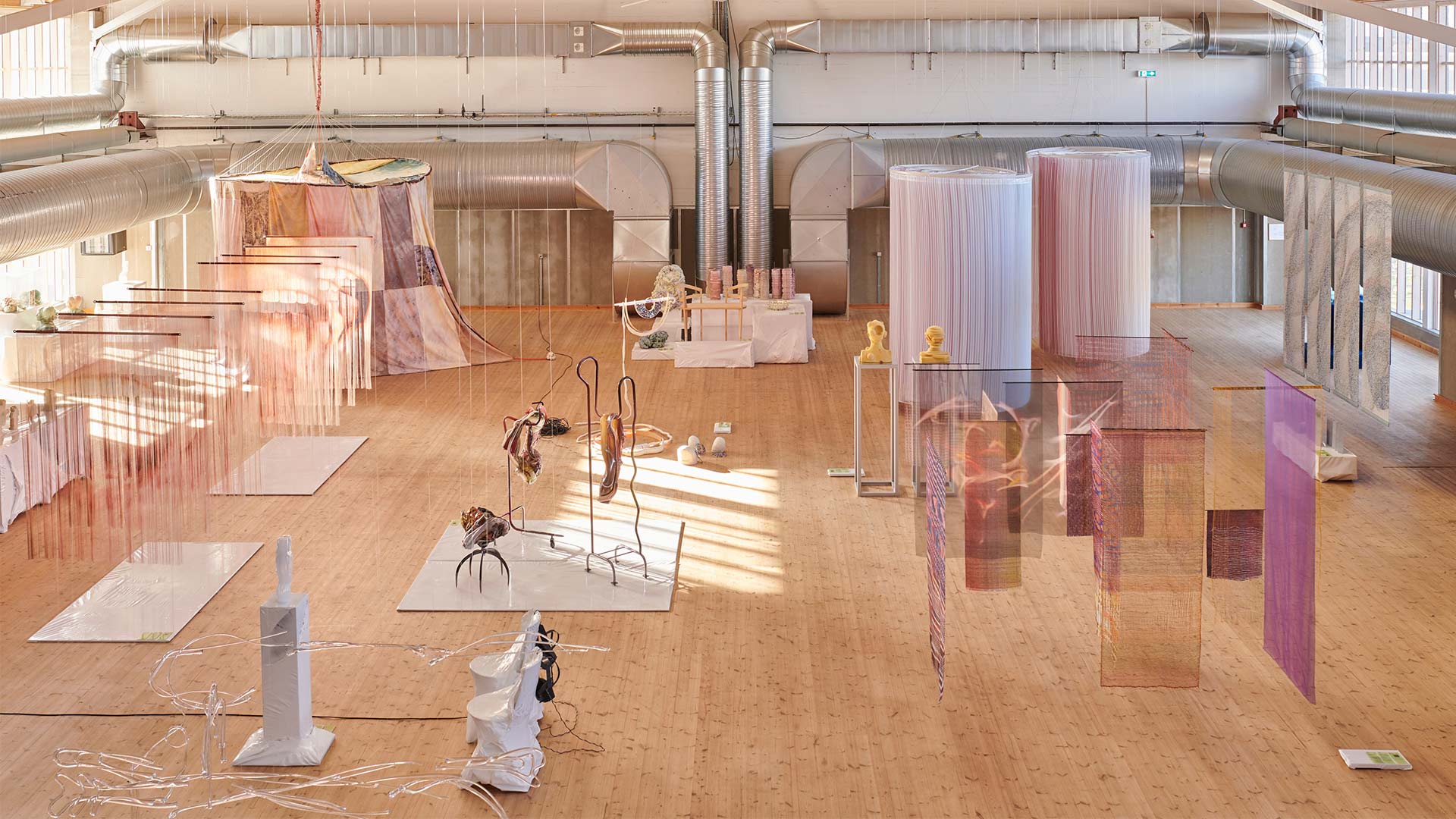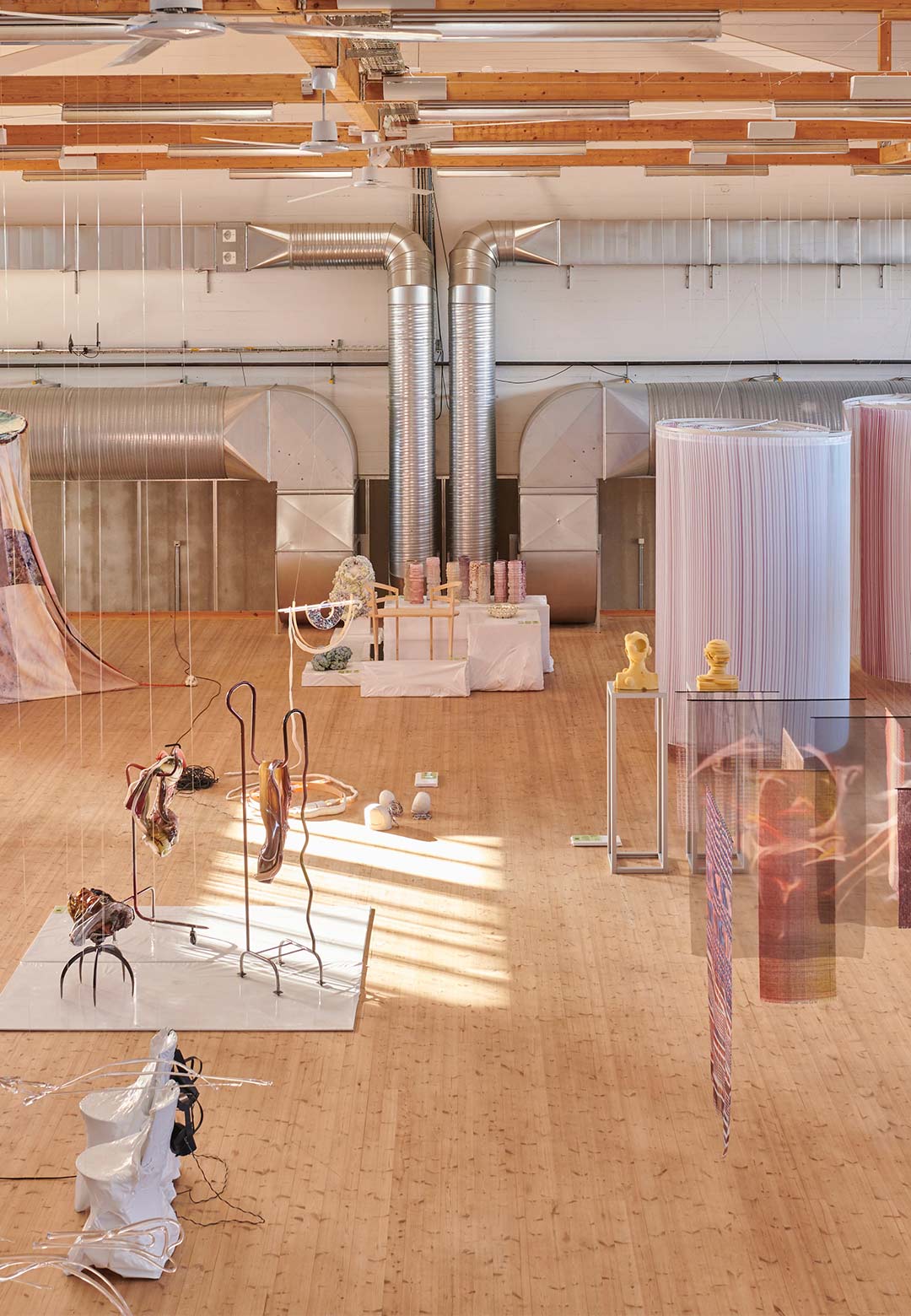“Settle in at the dinner table set for a digital meal. Experience AI generated daggers and the urn that smashes and converts to NFT. Or how about revisiting stolen artefacts, sold on eBay and recreated in 3D print?”
Thus reads curator Anne Thomasen's prologue to the 11th edition of The Biennale for Craft & Design, which invites visitors into the new digital age. The design biennale, which first started in 2002, takes place once every two to three years. The current iteration of the design event, which opened to the public on October 12, 2023, at Contemporary Copenhagen, will remain on view until November 12, 2023. The ongoing edition of the design exhibition seeks to address the theme of conversion, better understood as society’s ‘migration’ onto the digital landscape. Biennale for Craft & Design 2023 explores and expands on this theme through a curated show that offers a hybrid experience. Visitors can move through a material exhibition, a meta showcase and a web-based catalogue. “All practices have a substantial implementation of the digital in either the work process, the spaces they inhabit, or the areas they investigate and question. They touch upon ideas of form, scale and movement, comprehensions of perception and illusion, politics of spaces and bodies, as well as the many languages of man and machine,” shares Anne Thomasen, curator of the exhibition.
Hosted within the 658 square metre Hall 6 of Contemporary Copenhagen, in Copenhagen, Denmark, the exhibition, comprising 36 new works, seeks to address both, the utopian dreams envisioned in tandem with digital provisions, as well as the inhibitions related to these new developments. The event seeks to encourage a balanced and informed conversation about the digital medium. On the one hand, it platforms digital innovations and imaginations, and on the other, it invites criticism of various extant technologies and the internet. The exposition poses various pertinent questions such as: “What role does physical craftsmanship and design play in the digital space? Can an artwork be turned into an NFT - a digital collector's item - and what does it mean for the experience?”
The projects on display at the Danish design gallery engage with tradition while seeking to renew creative identities. They explore the potential of craftsmanship in the digital age. Some of the exhibitors from among the 36 participants include Lene Bødker, Esben Kaldahl, Pernille Snedker Hansen, Kristine Mansberg, Tronhjem Rømer, Tideland Studio, Rasmus Høj Mygind, Anders Nielsen, and Wang & Söderström. These designers and artists were selected by a jury comprising the curator Anne Thomasen; TABLEAU owner Julius Værnes Iversen; ceramist Hilda Piazzolla from the gallery Peach Corner; and curator and writer Charlotte Jul. While TABLEAU undertook the exhibition design, Anne Thomasen and digital artist Jonas Kasper Jensen worked with the exhibitors on the development and presentations of their works.
In addition to viewing the showcases physically, the exhibition also offers a chance to view these works in a digital Meta-universe. Enunctiating upon this aspect, Jensen shares, “We have experimented and ventured into unknown paths to create the best possible conditions for each work in the digital realm. It means that some works may appear differently than in the physical exhibition. The meanings of the works may be shifted, and entirely new artistic perspectives may emerge. Therefore, the Meta-universe should be understood as an experiment existing in an as-yet unexplored dimension."
Works like ‘Synthetic Futures’ by knit designer and textile artist Drua Sif Albrechtsen seeks to question the definition of a dress through a fabric installation designed digitally. The knit of the textile is programmed with the help of a colour-based pixel input, such that each pixel corresponds to a knitting needle. Another textile creation is ‘Soft Transformation’ by designer and textile artist Jens Ole Árnason. Inspired by the provisions afforded by augmented reality, this textile sculpture, where Árnason seeks to transform the flat textile into an organic sculptural three-dimensional object, also presents the limits to which the material can be stretched. Berthe Forchhammer and Miriam Brostrøm’s ‘Ripples in the Water’ is a linen and water showcase that is inspired by the word Blockchain. Just like blockchain grows and spreads, so does a ripple in water. Textile designer and fabric printer Bitten Hegelund’s ‘Pattern Scratches’ explores the impact of compositions, proportions, repetitions and colour variations in transforming the visual effect of a textile piece. The patterns drawn by Hegelund bear semblance to common digital patterns.
A digitally printed silk installation ‘Slips of the Tongue’ by visual artist Ruth Gilmour highlights the disregard of patients in the healthcare arena and the increasing integration of digital technology in this realm. “Gilmour challenges traditional craft norms to reveal how verbal blunders and digital glitches can exacerbate vulnerability,” reads an excerpt from the exhibition text. Weaver and textile designer Astrid Skibsted and multidisciplinary artist Michelle Yi Martin’s ‘Distortion and Imagination’ is a woven textile installation that explores the handwoven process in digital and analogue interactions. Some other works in the realm of textile art and textile design, on display at the design exhibition, include Kristine Mandsberg’s ‘Orbs’, Siff Pristed’s ‘Sphere', Trine Tronhjem and Liv Marie Rømer’s ‘Overprinted Spaces’, and Cæcilie Parfelt Vengberg and Rita Blue Biza’s ‘Planetarium.’
In keeping with the versatility of the exhibition, the biennale hosts glass artist Lene Bødker’s ‘Walking Stone,’ which comprises two sculptures that highlight nature’s pervasive trait of permeating all entities, living and non-living, with forces of life. Glassmaker Sally Xenia Christensen’s ‘Homage to Making’ comprises a glass path, glass sculpture and a virtual reality film, which come together to explore the analogue and the digital possibilities within glassmaking. Maria Koshenkova’s ‘The Caretakers,’ on the other hand, was conceived by the artist during a time of personal crisis. Through glass fixtures that look like intestines, Koshenkova aims to portray positivity in the face of violence. Ida Wieth’s ‘Double Down 2.0’ is a glass installation accompanied with audio recordings from the forest. The composite piece seeks to present a connection between the work’s original provenance (the forest) and its current location.
Ceramic designer Lisbet Thorborg Andersen’s ‘Windows of Vision’ is a porcelain object that the creative sculpted with the intent of performing reverse archaeology. “Something unknown emerges through my hands. The casting of my excavation reveals artefacts that point towards the future,” Andersen reveals. Another ceramic work, ‘Playing Whispers’ by Troels Flensted and Ragna Mouritzen, seeks to explore the co-existence of process and product, the immaterial and material. While a product manages to reach completion in the physical world, its immaterial foundation continues to exist in the Metaverse. Ceramicist Susanne Hangaard’s ‘Adas Algoritme’ comprise two stoneware and aluminium sculptures that can be viewed as transformed ceramic busts of Ada Lovelace. The pieces are configured using Lovelace’s own algorithms, developed in the 1800s for calculating Bernoulli numbers. Another similar-looking ceramic showcase is ‘The Janus Project,’ a recreation of the image of Janus, the god of beginnings and transitions, by Karen Harsbo. It comprises two sculptures, both of which are two-faced, serving as a representation of the interconnectedness of life cycles.
Amalie Vöge Jensen’s ‘Storage of Movement’ comprises a series of ceramic sculptures that examine the relationship between the human body and an object, in the context of the former’s movement around the latter. It also reflects the relationship between bodies and the digital world. Tideland Studio’s ‘The Stolen Collection,’ on the other hand, comprises nine ceramic works, each of which is a replica of a stolen cultural heritage item from the Middle East that have recently been sold through the eBay marketplace. “In a form of digital archaeology, AI and ceramic 3D printing are combined to capture and recreate these objects before they disappear into private art collections,” the studio shares. A few other works created by ceramic artists and designers include ‘Pixelization cmd C / cmd V’ by Theis Lorentzen; ‘BKD23_01 to BKD23_10’ by Anders Henckel Nielsen; ‘A Matter of Touch’ by Annelie Grimwade Olofsson; ‘The Journey of an Urn’ by Davide Ronco; ‘Artifacts’ by Esben Schakenda Kaldahl; and ‘Look but do not touch’ by Metha Stuart Wallace and Jamie Wallace.
Danish designer Pernille Snedker Hansen’s ‘Digital Seeds’ comprise three wooden sculptures that appear like living digital sculptures. “The seeds are 'planted' in the digital world, in the form of NFTs. Here, the seeds will germinate, grow and transform in the digital world in a yearly cycle, under the influence of data from geolocation and weather in real-time,” the designer mentions. Danish architect Marie Ramsing’s ‘Twin Chair’ is built upon the chair design that emerged when the creative fed Midjourney with the prompt: A chair designed to question the future of AI in arts and crafts. Anna Søgaard and Pil Whitta’s ‘Where Does the Cloud Live?’ poses the question of the cloud’s (which stores our data) location. With the help of a wooden structure, the designer and architect bring home the point that the ‘cloud’ is not solely a virtual entity and that it leaves a significant footprint on the planet.
Carl Johan Jacobsen’s ‘Between 2 worlds: Unreal Reality’ comprises two aluminium chairs that reflect the dichotomous yearnings within us that emerge as an impact of the endless choices we encounter in the digital sphere. Another example of furniture design serving as a medium for visceral transmission is Maiken Lindhardt’s ‘Staging.’ Lindhardt, who is a furniture designer, built four steel shelves that individually represent ‘human self-staging through storage concepts - display, concealment, and in-between spaces.’ Some other installations at the exhibition include Lise Bjerre Schmidt’s ‘A physical portrait of a digital human’; architect and designer Mikkel Nielsen’s ‘Soft Structures No. 6;’ Rasmus Høj Mygind’s ‘Untitled’ sculpture; and Justyna Poplawska’s ‘Your colour, I wish.’
During the inaugural event of the exhibition on October 12, the biennale also announced the Biennale Prize 2023, from among three nominees. Wang & Söderström’s ‘The Liminal Eatery’ was announced as the winner. The two other nominees for the position were Tideland Studio and Astrid Skibsted Holm & Michelle Yi Martin. Wang & Söderström’s ‘The Liminal Eatery’ is a phygital dining experience that ‘explores the digital shift of our sensory encounters, as activities like dining, writing, and socialising evolve into online routines.’ It seeks to question if digital engagements truly enliven our senses. “The universe has moved on to virtual reality. You put on the headset and find yourself in a new dimension. Here you experience the table and the meal in an immersive reality where you are suddenly joined by avatars. The accompanying sound is at once playful and inviting, yet uncanny - in both the physical and virtual worlds, you're left wondering whether you've entered a reality you want to escape or live in forever,” the award committee shares.
Some other events that are part of the biennale include the symposium Crafted Realities at the Royal Academy of Architecture, Design, and Conservation; and an NFT workshop with the digital artist Jonas Kasper Jensen.
The Biennale for Craft & Design 2023 is on view from October 12 - November 12, 2023 at Copenhagen Contemporary, Refshalevej 173 A, 1432 Copenhagen.
- Ceramic Artist
- Chair Design
- Copenhagen
- Craftsmanship
- Danish Architect
- Danish Design
- Danish Designer
- Denmark
- Design Event
- Design Exhibition
- Digital Artist
- Digital World
- Furniture Design
- Furniture Designer
- Glass Artist
- Glass Sculpture
- Glassmaking
- NFT
- Textile Art
- Textile Artist
- Textile Design
- Textile Designer
- Visual Artist






 Sign in with email
Sign in with email










What do you think?